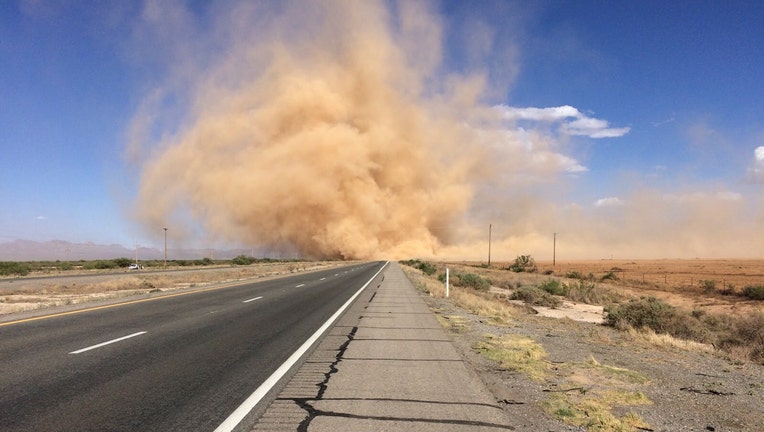ADOT: Dust warning system worked well during August storm

A dust storm in Arizona. (Arizona Dept. of Transportation)
TUCSON, Ariz. (AP) - A new high-tech system to detect dust and alert drivers on a dangerous stretch of Interstate 10 in the southern Arizona desert didn’t get much of a workout during this year’s meager monsoon, but officials say it worked well during one storm when traffic slowed significantly in response to warnings.
The $72 million warning system along 10 miles (16 kilometers) of I-10 in the Eloy area of Pinal County between Phoenix and Tucson includes sensors and overhead electronic message boards that display alerts about blowing dust and tell drivers to slow down.
Dust storms are common during the monsoon, and Arizona Department of Transportation officials said the system went operational in time for the monsoon’s June 15 start. The monsoon ended Sept. 30.
ADOT said researchers gathered noticeable measurements from one 20-minute August storm that prompted the system to lower the variable speed limit signs to 35 mph (56 kph) because of visibility dropping to less than 300 feet (91 meters), the Arizona Daily Star reported.
The system then recorded drivers slowing down to about 45 mph (72 kph), “a big drop from the normal 75 mph (121 kph) limit,” ADOT said in a statement.
“We do know that the system is working — it is doing what it’s supposed to,” said Kevin Duby, ADOT’s statewide road weather manager. “Our next step is to take the data we have to evaluate and determine the efficiencies of the system to improve performance.”
David Locher, an ADOT engineer, acknowledged that 2020′s lackluster monsoon was a mixed blessing.
“Less dust storms is obviously a good thing when it comes to driving conditions; however, we didn’t have the normal weather events that would have been ideal for data gathering in our first season,” he said.
The system is based on a long-range weather radar dish that sits atop a 22-foot-tall (6.7-meter-tall) pole at the I-10 interchange with Arizona 87 interchange. It can detect storms more than 40 miles (64 kilometers) away.
Several programmable speed limit signs are placed every 1,000 feet (305 meters) near the corridor’s entrance, and the signs shift speeds depending on the weather event. Additional signs are placed 2 miles (3.2 kilometers) apart.
ADOT’s staffed Traffic Operations Center in Phoenix is also part of the system.
The center uses closed-circuit cameras to identify conditions along the roadway and potentially more storms in the distance.
The dust detection system has been in officials’ minds since 2016 as researches reported accumulated crash data from 2010 and 2015 detailing weather events impacting the 10-mile corridor.
More than a decade ago, a system was installed along I-10 in southeastern Arizona from Benson to New Mexico. That system used wind speed to set off flashing signs that alerted drivers to the possibility of blowing dust.
You can check the latest weather conditions by visiting the FOX 10 Phoenix weather page, or download the Free FOX 10 Weather app, which is available on Apple iOS and Android.

